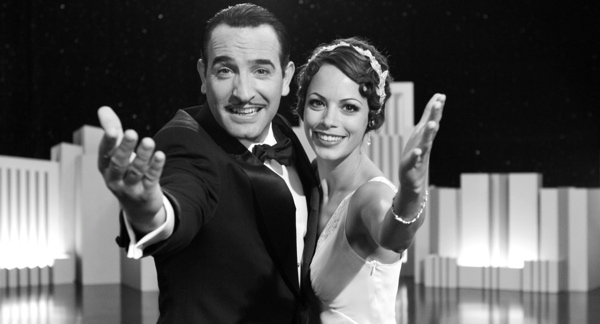By Ray Bennett
TORONTO – The word irresistible is bandied around a lot in reviews but it is the only way to describe Michael Hazanavicius’s marvellous black-and-white silent movie “The Artist”.
A treat for film lovers, it is set in Hollywood in the 1920s and tells of a headliner whose star is fading and a newcomer who is about to hit the heights as silent pictures give way to talkies.
Filmed in the boxy Academy ratio, the film was shot in colour and then adapted to sumptuous black-and-white with all the atmosphere of the time and the over-the-top screen acting that went with it. It is silent, but there some surprising and very funny tricks with sound.
Jean Dujardin, who starred in the director’s French spy spoofs, “OSS 117”, plays George Valentin, a gallant swashbuckler reminiscent of Douglas Fairbanks, whose derring-do is matched by his resourceful and equally talented Jack Russell terrier Uggie.
The film opens with a screening of Valentin’s latest smash hit and the handsome and debonair ham is shown as he takes in the applause of his adoring audience.
As the cameras flash outside the cinema, however, a jaunty young woman named Peppy Miller, played by Hazanavicius’ wife Bérénice Bejo, contrives to trip over the star and the fotogs egg the two on to share a kiss.
Headlines in the trades ask who is the mystery girl as Peppy lands a job as an extra in the same studio where Valentin works, and there’s a joyous scene in which, separated by a backdrop, they share dancing that leads to a meeting.
Enchanted, Valentin persuades his reluctant producer Al Zimmerman (John Goodman) to give her a job and another captivating sequence shows the pair doing retakes of a simple scene that they both fluff as they realise they have fallen in love.
It’s romantic and silly and utterly beguiling. But Zimmerman decides to make only talkies from then on and Valentin elects to try to buck the trend without success. The film follows his downward spiral as Peppy’s career takes off and there will be tears and much laughter before the exhilarating climax.
Guillaume Schiffman’s cinematography is filled with ravishing black-and-white images that evoke not only the days of silent films but also the way movies will develop into the ’40s with homages to Orson Welles pictures and more.
French composer Luduvic Bource provides a vast range of musical styles to capture the comedy, drama and pathos, and the director adds many cues from top composers from Hollywood’s golden age that only add to the fun. Buffs might object to the use of one of Bernard Herrmann’s themes from “Vertigo” in a crucial scene, but it works beautifully.
Goodman is perfectly pugnacious as the no-nonsense producer and James Cromwell evokes the character actors of the time with his droll performance as a loyal chauffeur. Familiar faces such as Penelope Ann Miller, Ed Lauter, Missy Pyle and Ed Lauter also contribute vivid moments.
The comic timing and lovely dancing that Dujardin and Bejo display will endear them to audiences who cherish movie entertainment of the highest order. There is a sly moment at the end when the French director reminds us how important Europeans were to the development of Hollywood.
There will be adoring audiences, and there will be awards.
Venue: Toronto International Film Festival; UK release: Dec. 30, Entertainment; Cast: Jean Dujardin, Berenice Bejo, John Goodman, James Cromwell, Penelope Ann Miller, Missi Pyle, Malcolm McDowell, Ed Lauter; Director, screenwriter: Michel Hazanavicius; Producer: Thomas Langmann; Director of photography: Guillaume Schiffman; Production designer: Laurence Bennett; Music: Ludovic Bource; Editors: Anne-Sophie Bion, Michel Hazanavicius; Costume designer: Mark Bridges; Executive producers: Daniel Delume, Antoine De Cazotte, Richard Middleton; Production: Thomas Langmann presents a La Petite Reine, Studio 37, La Classe Americaine, JD Prod, France3 Cinema, Jouror Production-uFilms co-production; UK rating 12A, runs 100 minutes.

